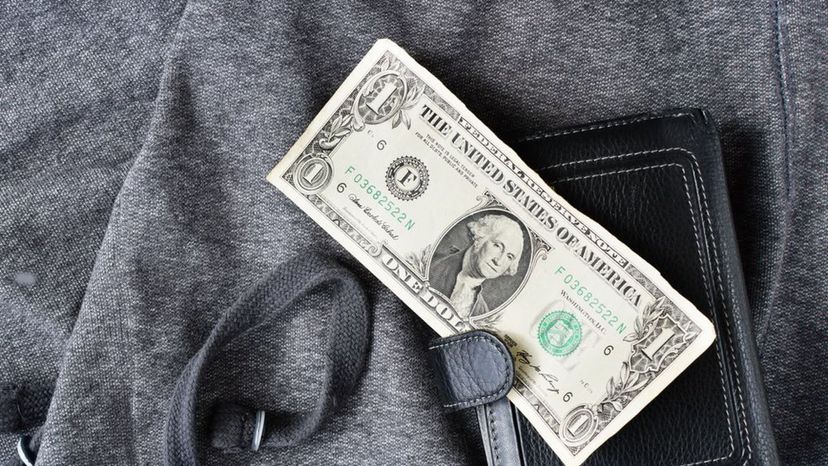
About This Quiz
United States currency is the most powerful on Earth, mostly thanks to the strength of the country's economy. How much do you know about American currency?The $1 bill pyramid has a weird eye on top. The eye is meant to represent America's favor in the eye of the universe's creator.
We call it "paper" money, but it's not actually paper. American bills are made from a cotton/linen blend that's much more rugged than any paper.
The United States Bureau of Engraving and Printing is responsible for creating the currency we use. Each day, the agency prints hundreds of millions of dollars worth of currency.
Advertisement
It takes about 2.4 cents to make a single penny. It's ironic, yes, and one of many reasons that so many people would like to do away with the one-cent coin.
Many countries don't even bother with paper bills worth less than $5. But in America, the $1 bill is king. In 2015, there were more than 11 billion of these bills in circulation.
One of America's Founding Fathers -- Thomas Jefferson -- is the man on the $2 bill. It's the reason that $2 bills are sometimes called "Toms."
Advertisement
In the history of U.S. currency, only one woman's portrait has ever appeared on paper bills. That would be Martha Washington, whose picture graced $1 certificates back in the late 1800s.
There are no $75 bills in circulation. The government generally produces these denominations for circulation: $1, $5, $10, $20, $50, and $100.
The first pennies were made from pure copper. These days, copper is far too valuable, so pennies are mostly zinc with just a thin coating of copper.
Advertisement
$100 bills have a 3-D security ribbon woven into the material. The symbols on the ribbon change as you move the bill back and forth and up and down.
There have been some $100,000 bills printed. But they weren't put into circulation, they were used for transactions between federal banks.
Those measly $1 bills are pretty tough. They can remain in circulation for nearly 2 years before they're finally too battered to be of any good.
Advertisement
The green inks used in American currency is very durable and resistant to discoloration and flaking. In America, green is the color of money.
There's a widely held misconception that $2 bills are no longer printed. But that's false. The Feds actually print $2 bills, but in much lower quantities than other denominations.
The $1 bill is a popular denomination in America. Roughly 40% of all paper bills printed each year are $1.
Advertisement
American coins can withstand regular use for about a generation -- 25 years of moderate use. After that, they're often too battered for circulation.
In 1862, a time of American war, people were hoarding metal coins. So the government began producing paper money in hopes of restoring normal currency circulation.
The $100 bill has the longest circulation time, simply because this denomination doesn't get used all that often compared to, say, $5 bills. They typically last more than 15 years in circulation.
Advertisement
"Annuit Coeptis" essentially means "He favors our undertaking." It's a clever way of saying that the American experiment was supposedly dear to the great maker of the universe.
In 1969, the Feds stopped making very large paper denominations, such as $500 and $5,000, which were mostly used for bank transactions. Improved electronic transaction methods made these huge bills obsolete.
Prior to the Civil War, banks were responsible for printing paper money. Of course, this system caused a lot of confusion (and massive counterfeiting) so once the Union was restored, the Feds wisely centralized the process of currency production.
Advertisement
It's true, for decades, foreign coins were absolutely prized as currency. Why? Because until the mid-1800s, America still hadn't discovered enough sources of precious metals to make its own coins.
The pyramid has 13 steps that represent the 13 original colonies. And the steps remain unfinished, as if the designer knew America would soon be adding to its territorial haul.
In the 2000s, in an effort to stay ahead of counterfeiters, the government integrated a security thread into paper bills. The thread glows when exposed to ultraviolet light.
Advertisement
The U.S. government prints billions of dollars worth of paper money each year. The official name for this currency is Federal Reserve notes.
In 1966, the Feds stopped printing $2 bills because the American public didn't really like them. For 10 years, the $2 bill was sent into hibernation.
In 1976, the Feds brought back the $2 bill for a very simple reason -- to save money on printing costs. It costs the same amount of money to print either $1 or $2 bills, but with the latter, the government could put twice as much value into circulation.
Advertisement
The first $1 bill, produced in 1863, featured Salmon Chase, the Secretary of the Treasury, because, you know, why not? His egotistical move didn't last long -- in 1869, George Washington replaced him.
So far, no black Americans have made it onto a paper bill. But three black men, including Booker T. Washington, have had their faces engraved onto commemorative coins.
The American dollar is prized for its value around the world. By some estimates, about two-thirds of American money is in circulation outside the U.S.
Advertisement